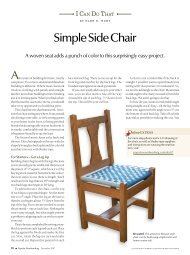In the Gutter
In the Gutter
In the Gutter
- No tags were found...
Create successful ePaper yourself
Turn your PDF publications into a flip-book with our unique Google optimized e-Paper software.
<strong>In</strong> <strong>the</strong> <strong>Gutter</strong>The result of gutterspikes pulling loosefrom fascia board.The gutters on your home are designed to collectand disperse <strong>the</strong> water that runs off yourroof. Without <strong>the</strong> gutters, rainwater simplyfalls directly off <strong>the</strong> eaves and ends up way tooclose to your house’s foundation. This can leadto serious problems, like flooded basementsand crawl spaces, cracked concrete or cinderblockfoundation walls. And don’t forget thatnasty, moldy, mildewy smell that gets embarrassingwhen company comes over!Keeping your gutters and downspouts ingood shape is a wise investment, both financiallyand in terms of your hard-earned sparetime. <strong>In</strong> most cases, you should be able to getyour system in tip-top shape for less than acouple hundred bucks. That pales in comparisonto foundation repair — or replacement,as I once had to do. That bill was a measly$46,000. I’ll let you do <strong>the</strong> math.<strong>Gutter</strong>s and downspouts (<strong>the</strong> black dots) collect water from <strong>the</strong> roof anddisperse it away from your home’s foundationPieces and PartsThe gutters <strong>the</strong>mselves will ei<strong>the</strong>rbe of <strong>the</strong> seamless variety (generallyinstalled by professionals) orinstalled as sections (anywhere from10 to 16 ft. in length). Both typesuse some type of fastening system tokeep <strong>the</strong>m in place. The most commonis <strong>the</strong> gutter spike.Over time, <strong>the</strong>se spikes tend towork <strong>the</strong>mselves loose from <strong>the</strong>fascia board that <strong>the</strong>y’re fastened to(left). This is most likely because<strong>the</strong>y split <strong>the</strong> wood when <strong>the</strong>y wereinstalled and weren’t sealed properlyto prevent moisture from seepinginto <strong>the</strong> fascia and swelling <strong>the</strong>wood. As we say in <strong>the</strong> South, <strong>the</strong>holes got wallered out.The best fix for this problemis called a gutter screw. It’s like aspike, but better — instead of beingpounded in like a nail, it screws inusing a drill/driver. <strong>In</strong> most cases,gutter screws are designed to beused in <strong>the</strong> same holes that <strong>the</strong>spikes came loose from, making <strong>the</strong>swap pretty simple. Just rememberto use <strong>the</strong> sleeve provided with <strong>the</strong>new screw or <strong>the</strong> one that came off<strong>the</strong> old spike, if it fits. This preventsyou from over-driving <strong>the</strong> screw andcrushing your gutter...leading toano<strong>the</strong>r repair expense!This one simple fix can save literallythousands of dollars in repairsdue to gutter failure and <strong>the</strong> resultingwater damage to your eaves andfoundation!(Middle right) A gutter screw with includedsleeve. (Right) <strong>In</strong>stall gutter screws with adrill/driver and be sure to use <strong>the</strong> sleeveto avoid damaging <strong>the</strong> gutter!20 C h a p t e r O n e s ta r t i n g o u t s i d e 21
Plastic MeshSecond in line is <strong>the</strong> plastic-mesh style. It installs by sliding over<strong>the</strong> entire front lip of your home’s gutters. The challenge can begetting it to fit snugly over areas where <strong>the</strong> gutter may be bent.It is less prone to bending than <strong>the</strong> wire-mesh and has <strong>the</strong> addedadvantage of possibly matching your gutter’s color — as long as it’swhite, off-white or brown (in most cases).Dispersing <strong>the</strong> WaterEvery gutter system should have several downspouts. Their job is to carry<strong>the</strong> water collected by <strong>the</strong> gutter and channel it away from <strong>the</strong> foundationof <strong>the</strong> house. Sounds simple enough, but problems can arise quicklywhen <strong>the</strong>y become clogged or simply drain too close to <strong>the</strong> exterior wall.The first problem is often alleviated when gutter toppers are installed,but before that time, leaves and debris collected by <strong>the</strong> gutter can causea virtual logjam at <strong>the</strong> downspout’s entry point inside <strong>the</strong> gutter. For thisreason, it’s important to clear any debris from <strong>the</strong> gutter before it gets tothat point.If <strong>the</strong> gutter gunk finds its way into <strong>the</strong> downspout, it can cause a clogyou can’t even see. This can force water out through unsealed joints orworse, back into <strong>the</strong> gutter itself, adding to that weight issue we discussedearlier. See how this is all connected?So, let’s stop <strong>the</strong> problem before it starts.This plastic-mesh style has a lower profile and tendsto be more “invisible” than o<strong>the</strong>r styles.Solid PlasticLast, and holding <strong>the</strong> distinction of being myfavorite method of gutter protection, are <strong>the</strong>solid plastic sections that use friction to directwater into <strong>the</strong> gutter. These allow leaves ando<strong>the</strong>r debris to roll off <strong>the</strong> leading edge andfall to <strong>the</strong> ground, where you’re forced to rake<strong>the</strong>m up or mow <strong>the</strong>m into mulch, which inturn fertilizes your lawn!“Solid” plastic guards also snap along <strong>the</strong> front edgeof <strong>the</strong> gutters and slide underneath <strong>the</strong> first layer ofshingles.All you need is a garden hose toclear most clogs from a downspout.Just insert it at <strong>the</strong> top and turn it on.The water pressure should dislodgeany stubborn debris from inside,which will <strong>the</strong>n come rushing out <strong>the</strong>bottom; this is a good reason to standback a bit to avoid getting any of thatsmelly decomposing stuff on you.Once <strong>the</strong> downspouts are cleared,take a look at where <strong>the</strong>y empty out.Traditional wisdom says <strong>the</strong>y shouldsend <strong>the</strong> water anywhere from 2to 4 feet away from your home’sfoundation. That’s a pretty good ruleof thumb.24 C h a p t e r O n e s ta r t i n g o u t s i d e 25
Splash blocks are a good way toensure that <strong>the</strong> water heads off into<strong>the</strong> yard and not back up against<strong>the</strong> house. They should be installedso that <strong>the</strong> open end is toward youryard. O<strong>the</strong>rwise, water can roll backup <strong>the</strong> sloped form and back upagainst your house. You know howthat story can end.One reason some people turn <strong>the</strong>irsplash blocks around is because <strong>the</strong>ycan cause some erosion to occur aswater rushes down and into <strong>the</strong> soil,particularly during heavy rains. A bettersolution to this problem is usingan inexpensive device (around $10)called a downspout drain. You simplyattach it to to <strong>the</strong> end of <strong>the</strong> downspoutwith <strong>the</strong> included bracket.During dry periods, <strong>the</strong> disperserstays neatly coiled and out of <strong>the</strong> way.When it rains, though, it uncoilsand disperses <strong>the</strong> water over a widerarea, with less chance of erosion. Itcan actually be a source of entertainmentif you get really bored.Brad’s TipTo move water even far<strong>the</strong>r into youryard, simply install a short section ofdownspout (anywhere from two to fourfeet in length), to <strong>the</strong> end of your existingdownspout, <strong>the</strong>n add <strong>the</strong> downspoutdrain. I used this method tocarry water out past a client’s shrubsand into her yard, where it drainedharmlessly away from her alreadycracked foundation.Sloping <strong>the</strong> EarthThis step requires a little heavy lifting, as youcan imagine. Actually, we’re just talking aboutsloping <strong>the</strong> earth (small “e”) around yourhome’s foundation so that any water that happensto hit it will have a tendency to roll awayfrom your house as opposed to slamming into<strong>the</strong> exterior wall.Remember I said that water will find a way?It’s true. Water that lands next to <strong>the</strong> foundationcan soak down through <strong>the</strong> soil, under <strong>the</strong> con-crete slab or through <strong>the</strong> foundation wall, andcause a whole lot of damage. That’s why youneed to check all areas around your home andparticularly around downspouts and flower beds.Be sure <strong>the</strong> dirt is sloped at least 1 ∕8 inch forevery linear foot it travels from <strong>the</strong> house. Ifyou have to buy dirt to fill in low spots, just doan online search for “fill dirt” in your area orcheck with a landscaper or contractor nearbyand ask <strong>the</strong>m where to find <strong>the</strong> best deal.Improperly Sloped LandProperly Sloped Land26 C h a p t e r O n e s ta r t i n g o u t s i d e 27
















